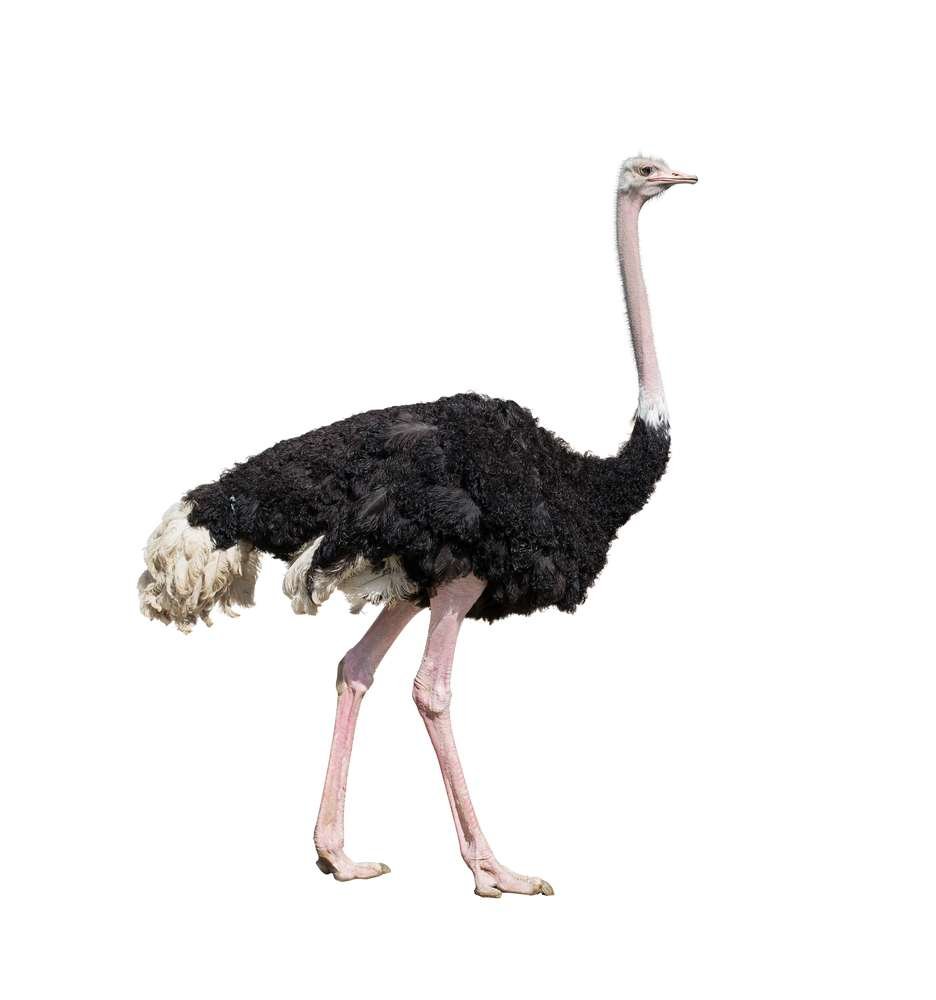Southern Ostrich
( Mwakatala, Black Necked Ostrich or South African Ostrich )
- Struthio camelus australis
- IUCN Status: Least Concern
- Trend: decreasing

- Kingdom: Animalia
- Phylum: Chordata
- Class: Aves
- Order: Struthioniformes
- Family: Struthionidae
- Genus: Struthio
Share:
General Information
The Southern ostrich is a subspecies of the common ostrich endemic to Southern Africa. It is the largest bird and it has 5 subspecies
Fun Facts!
Southern ostriches have the largest eyes of any land vertebrate (5 cm in diameter) which help them to see predators at a great distance. They are also the fastest two legged animal for reaching speeds of up to 80 km/h. Ostrich eggs are the largest of all eggs (on average they are 15 cm long, 13 cm wide, and weigh 1.4 kg). Contrary to popular belief, ostriches do not bury their heads in sand to avoid danger.
Description
The feathers of adult males are mostly black, with white primaries and a white tail. However, the tail of one subspecies is buff. Females and young males are grayish-brown and white. The head and neck of both male and female ostriches is nearly bare, with a thin layer of down. The skin of the female’s neck and thighs is pinkish gray, while the male’s is gray or pink dependent on subspecies. New chicks are fawn in color, with dark brown spots.
- Weight: 63 - 145 kg
- Lifespan: 40 – 45 yrs in the wild and up to 63 yrs in captivity
Ecology and Behaviour
Ostriches are diurnal, but may be active on moonlit nights. They are most active early and late in the day. The male common ostrich territory is between two and twenty square kilometres. When being pursued by a predator, they have been known to reach speeds in excess of 70 km/h (40 mph), or possibly 80 km/h (50 mph) and can maintain a steady speed of 50 km/h (30 mph), which makes the common ostrich the world’s fastest two-legged animal. When threatened, common ostriches run away, but they can cause serious injury and death with kicks from their powerful legs. Their legs can only kick forward.
Diet
Southern ostriches mainly feed on seeds, shrubs, grass, fruit, flowers, locusts, small reptiles such as lizards, and occasionally animal remains left by carnivorous predators
Reproduction
Common ostriches become sexually mature when they are 2 to 4 years old. The female common ostrich lays her fertilized eggs in a single communal nest. The dominant female lays her eggs first; when it is time to cover them for incubation, she discards extra eggs from the weaker females
Conservation
It is listed by the International Union for Conservation of Nature (IUCN) as, ” Least Concern “.
Distribution and Habitat
The Southern ostrich is found in South Africa, Namibia, Zambia, Zimbabwe, Angola and Botswana. It lives in south of the Zambezi and Cunene rivers.
Interaction with humans
It is widely farmed for its meat, eggs and feathers. Common ostriches typically avoid humans in the wild, since they correctly assess humans as potential predators. If approached, they often run away, but sometimes ostriches can be very aggressive when threatened, especially if cornered, and may also attack if they feel the need to defend their territories or offspring. Similar behaviors are noted in captive or domesticated common ostriches, which retain the same natural instincts and can occasionally respond aggressively to stress. When attacking a person, common ostriches deliver slashing kicks with their powerful feet, armed with long claws, with which they can disembowel or kill a person with a single blow.
No donation to this project yet.
| M | T | W | T | F | S | S |
|---|---|---|---|---|---|---|
| 1 | 2 | 3 | 4 | 5 | 6 | 7 |
| 8 | 9 | 10 | 11 | 12 | 13 | 14 |
| 15 | 16 | 17 | 18 | 19 | 20 | 21 |
| 22 | 23 | 24 | 25 | 26 | 27 | 28 |
| 29 | 30 | 31 | ||||


